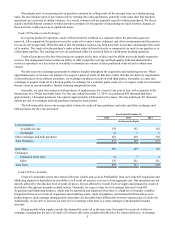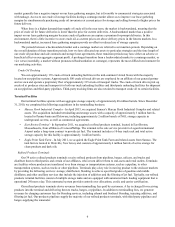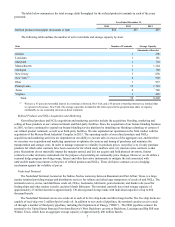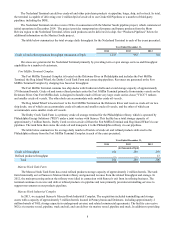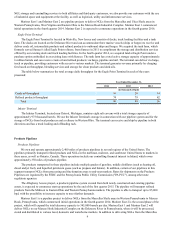Sunoco 2014 Annual Report Download - page 17
Download and view the complete annual report
Please find page 17 of the 2014 Sunoco annual report below. You can navigate through the pages in the report by either clicking on the pages listed below, or by using the keyword search tool below to find specific information within the annual report.15
30 years after the closing of the IPO. This indemnity will cover the costs associated with performance of the assessment,
monitoring, and remediation programs, as well as any related claims and penalties. See "Environmental Regulation—General."
We have experienced several petroleum and refined product releases for which we are not covered by an indemnity from
Sunoco, and for which we are responsible for necessary assessment, remediation, and/or monitoring activities. We have also
purchased certain pipeline and terminal assets for which we assume remediation responsibilities. Our management estimates
that the total aggregate cost of performing the currently anticipated assessment, monitoring, and remediation activities at these
sites is not material in relation to our operations, financial position or cash flows at December 31, 2014. We have implemented
an extensive inspection program to prevent releases of crude oil, refined products or NGLs into the environment from our
pipelines, gathering systems, and terminals. Any damages and liabilities incurred due to future environmental releases from our
assets have the potential to substantially affect our business and our ability to generate the cash flows necessary to make
distributions or satisfy debt obligations.
Rate Regulation
General Interstate Regulation
Interstate common carrier pipeline operations are subject to rate regulation by the FERC under the Interstate Commerce
Act, the Energy Policy Act of 1992, and related rules and orders. The Interstate Commerce Act requires that tariff rates for
petroleum pipelines be "just and reasonable" and not unduly discriminatory. This statute also permits interested persons to
challenge proposed new or changed rates and authorizes the FERC to suspend the effectiveness of such rates for up to seven
months and to investigate such rates. If, upon completion of an investigation, the FERC finds that the new or changed rate is
unlawful, it is authorized to require the carrier to refund revenues in excess of the prior tariff during the term of the
investigation. The FERC also may investigate, upon complaint or on its own motion, rates that are already in effect and may
order a carrier to change its rates prospectively. Upon an appropriate showing, a shipper may obtain reparations for damages
sustained for a period of up to two years prior to the filing of a complaint.
The FERC generally has not investigated interstate rates on its own initiative when those rates, like those we charge, have
not been the subject of a protest or a complaint by a shipper. However, the FERC could investigate our rates at the urging of a
third party if the third party is either a current shipper or has a substantial economic interest in the tariff rate level. Although no
assurance can be given that the tariffs charged by us ultimately will be upheld if challenged, management believes that the
tariffs now in effect for our pipelines are in compliance with the rates allowed under current FERC guidelines.
We have been approved by the FERC to charge market-based rates in most of the refined products locations served by
our pipeline systems. In those locations where market-based rates have been approved, we are able to establish rates that are
based upon competitive market conditions.
Intrastate Regulation
Some of our pipeline operations are subject to regulation by the Railroad Commission of Texas ("Texas R.R.C.") and the
Pennsylvania Public Utility Commission ("PA PUC"). The operations of our joint venture interests are also subject to regulation
in the states in which they operate. The applicable state statutes require that pipeline rates be nondiscriminatory and provide no
more than a fair return on the aggregate value of the pipeline property used to render services. State commissions generally
have not initiated an investigation of rates or practices of petroleum pipelines in the absence of shipper complaints. Complaints
to state agencies have been infrequent and are usually resolved informally. Although management cannot be certain that our
intrastate rates ultimately would be upheld if challenged, we believe that, given this history, the tariffs now in effect are not
likely to be challenged or, if challenged, are not likely to be ordered to be reduced.
Title to Properties
Substantially all of our pipelines were constructed on rights-of-way granted by the apparent record owners of the property
and, in limited instances, these rights-of-way are revocable at the election of the grantor. Several rights-of-way for the pipelines
and other real property assets are shared with other pipelines and other assets owned by affiliates of Sunoco and by third
parties. In many instances, lands over which rights-of-way have been obtained are subject to prior liens that have not been
subordinated to the right-of-way grants. We have obtained permits from public authorities to cross over or under, or to lay
facilities in or along, watercourses, county roads, municipal streets, and state highways and, in some instances, these permits
are revocable at the election of the grantor. We have also obtained permits from railroad companies to cross over or under lands
or rights-of-way, many of which are also revocable at the grantor’s election. In some cases, property for pipeline purposes was
purchased in fee. In some states and under some circumstances, we have the right of eminent domain to acquire rights-of-way
and lands necessary for the common carrier pipelines. The previous owners of the applicable pipelines may not have
commenced or concluded eminent domain proceedings for some rights-of-way.


